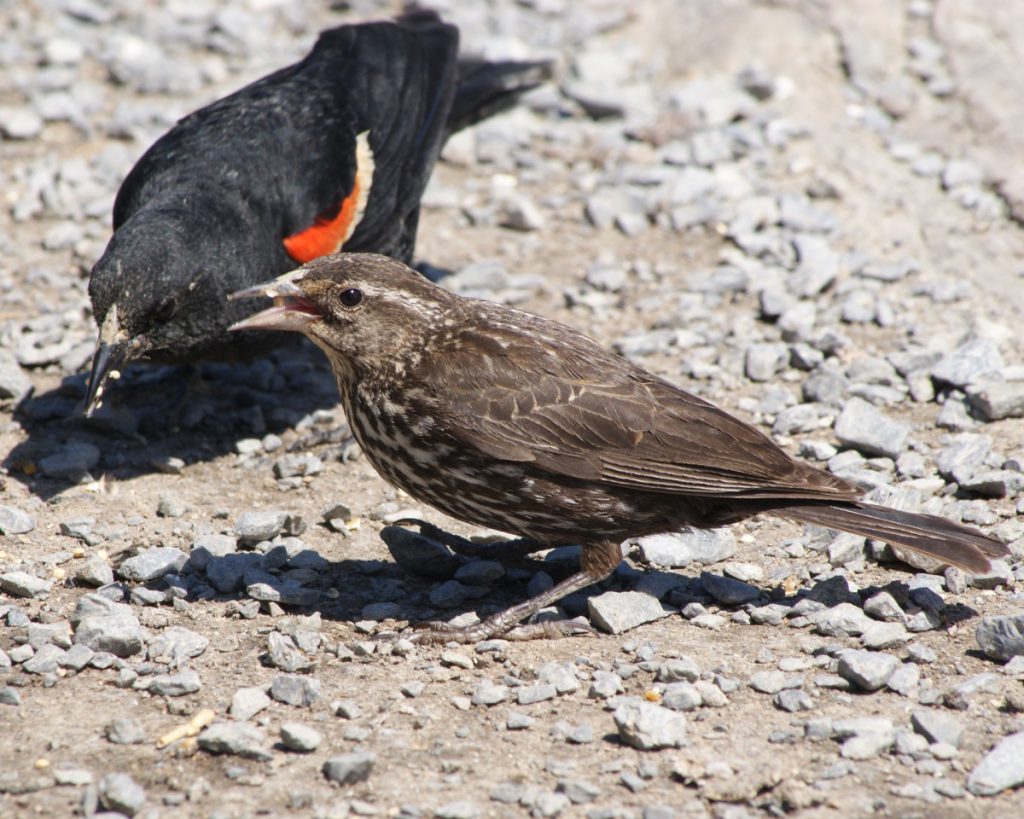Order: Passeriformes
Family: Icteridae
Genus: Aves
Species: Agelaius phoeniceus
Introduction
The Red-winged Blackbird is robin sized (male and female), ranging from 6.7″-9.1″, 1.1-2.7 oz, with a wingspan between 12.2″-15.8″. (All About Birds, 2017) The male body is all black, with orange-red pigment on the shoulders, with the yellow stripe along the bottom of the orange/red on shoulder. The female’s are more of a tan-brown color with darker brown streaks on it from head to tail.

English: Distribution map of Red-winged Blackbird (Agelaius phoeniceus).
Breeding: Blue
Year-round: Green
Wintering: Orange
Adapted from: Jaramillo, Alvaro and Peter Burke, New World Blackbirds, Christopher Helm, London, 1999, 431 p. (ISBN 0713643331) (OCLC 40798493
Red-Winged Blackbirds are spread across the United States, Canada and Central America. A team of researchers from United States Department of Agriculture and a couple other fields from Canada analyzed stable-hydrogen, nitrogen and carbon isotope ratios in feathers to further understand not only the food diet, but to also understand its molt origin. (Werner et al. 2016)
You will find them in damp area’s such as: marshes, ponds, ditches and agricultural lands for sure. The Red-Winged Blackbird is a generalist, as in they can deal with environmental changes and adapt better than some. They are able to adapt to urban environments and other forms of habitat fragmentation.

A Red-winged Blackbirds in George C. Reifel Migratory Bird Sanctuary, British Columbia, Canada. The female is in the foreground and the male is in the background.
When it isn’t breeding season, mixed flocks of blackbirds get together for foraging in agricultural crops. (Dolbeer et al. 1978) While the female is out foraging, it delays its time coming back giving off miss cues where the nest could possibly be, if being watched. Females are able to communicate with the nestlings and tell them to be quiet or that it is appropriate to be loud. The birds food diet can be tested through its feathers by testing isotope ratios, and through that it can tell if the bird was migrating. (Yasukawa et al. 2010)
Male, Call
https://www.xeno-canto.org/318816
Male, song
https://www.xeno-canto.org/314546

https://www.flickr.com/photos/greatsanddunesnpp/34175006724
Flashing his colors on display, marking his territory.
The Red-winged Blackbirds have high predation rates on nests. The Red-wing Blackbird is also known for being loud when predators or threats are getting too close to its nest. And also is known for being aggressive at times. (Yasukawa, 1979)
Adams, H. L., Burger, L. W., & Riffell, S. (2013). Disturbance and landscape effects on avian nests in agricultural conservation buffers. The Journal of Wildlife Management,77(6), 1213-1220. doi:10.1002/jwmg.568
Buxton, V. L., Santymire, R. M., & Benson, T. J. (2018). Mixed effects of urbanization on density, nest survival, and nestling corticosterone of a generalist passerine. Ecosphere,9(12). doi:10.1002/ecs2.2517
Cartwright, L., Taylor, D., Wilson, D., & Chow-Fraser, P. (2014). Urban noise affects
song structure and daily patterns of song production in Red-winged Blackbirds ( Agelaius phoeniceus). Urban Ecosystems, 17(2), 561–572. https://doi-org.evergreen.idm.oclc.org/10.1007/s11252-013-0318-z
Conover, R. R., Dinsmore, S. J., & Burger, L. W. (2011). Effects of conservation practices on bird nest density and survival in intensive agriculture. Agriculture, Ecosystems & Environment,141(1-2), 126-132. doi:10.1016/j.agee.2011.02.022
Gillespie, M. K., & Dinsmore, S. J. (2014). Nest survival of Red-winged Blackbirds in agricultural areas developed for wind energy. Agriculture, Ecosystems & Environment,197, 53-59. doi:10.1016/j.agee.2014.07.012
Kopec, A. D., Bodaly, R., Lane, O. P., Evers, D. C., Leppold, A. J., & Mittelhauser, G. H. (2018). Elevated mercury in blood and feathers of breeding marsh birds along the contaminated lower Penobscot River, Maine, USA. Science of The Total Environment,634, 1563-1579. doi:10.1016/j.scitotenv.2018.03.223
Sayler, R. D., Monda, M. J., Tabor, J. E., & Creighton, J. H. (1997). Effects of wetland
excavation on avian communities in eastern Washington. Wetlands, 17(2), 216. Retrieved from http://search.ebscohost.com.evergreen.idm.oclc.org/login.aspx?direct=true&db=eih&AN=8463476&site=ehost-live
Short, H. L. 1985. Habitat suitability index models: Red-winged blackbird. U.S. Fish
Wildl. Serv. Biol. Rep. 82(10.95). 20 pp.
Werner, S. J., Deliberto, S. T., Pettit, S. E., & Mangan, A. M. (2014). Synergistic effect of an ultraviolet feeding cue for an avian repellent and protection of agricultural crops. Applied Animal Behaviour Science,159, 107-113. doi:10.1016/j.applanim.2014.06.012
Werner, S. J., Hobson, K. A., Wilgenburg, S. L., & Fischer, J. W. (2016). Multi-Isotopic (δ2H, δ13C, δ15N) Tracing of Molt Origin for Red-Winged Blackbirds Associated with Agro-Ecosystems. Plos One,11(11). doi:10.1371/journal.pone.0165996
Whittingham, L. A., & Robertson, R. J. (1994). Food Availability, Parental Care and Male
Mating Success in Red-Winged Blackbirds (Agelaius phoeniceus). The Journal of Animal Ecology, 63(1), 139. doi:10.2307/5590
Yasukawa, K. (2013). Effects of age and experience on the responses of territorial and floater male Red-winged Blackbirds to models of receptive females. Journal of Field Ornithology,84(4), 377-388. doi:10.1111/jofo.12037
Yasukawa, K., Dorjath, E. J., & Morgan, S. K. (2017). Dynamics of territory acquisition in red-winged blackbirds, Agelaius phoeniceus. The Wilson Journal of Ornithology,129(3), 637-640. doi:10.22215/etd/1991-01933
.



Leave a Reply